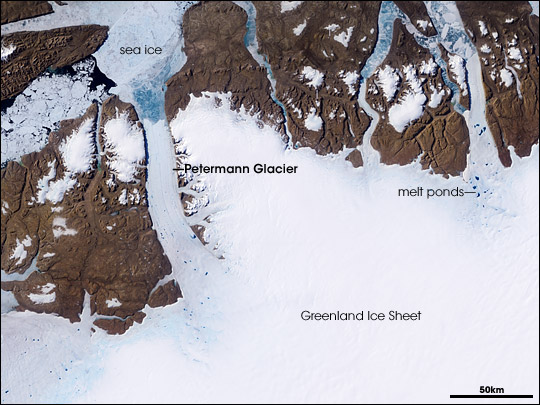

Why Does the Greenland Ice Sheet Matter? | |||
The Greenland Ice Sheet blankets 81 percent of Greenland Island. This monstrous ice slab stretches 2,480 kilometers (1,540 miles) long and up to 750 kilometers (465 miles) wide. The ice sheet is so big it would stretch from Key West, Florida, to 100 miles beyond Portland, Maine, covering a swath as wide as from Washington, D.C., to Indianapolis, Indiana. It’s 80 percent as big as the entire United States east of the Mississippi River. It’s not only huge, it’s also thick—an average of 2.3 kilometers (1.6 miles) thick. It contains roughly 8 percent of all of Earth’s fresh water. |
|||
 | |||
Greenland’s Ice Sheet matters for four reasons:Sea level: As the Greenland Ice Sheet melts, sea level rises. It is a direct, proven effect. This is the biggest reason for concern over Greenland. Scientists estimate that if the entire ice sheet melted, sea level would rise 23 feet. Depending on how rapidly such a change occurred, it could be a global-scale catastrophe because nearly one-third of the world’s population lives in or near a coastal zone. The global impact of several billion refugees and the negative impacts on coastal economic activity would be staggering. A sea level rise of only two to three feet—the high end of current plausible scenarios for the next 20 years—would create serious global problems: increased coastal erosion, salt water encroachment, loss of barrier formations (islands, sand bars, and reefs), and increased storm surge damage. Through the 1990s, sea level rose at a rate of about 3 millimeters per year. The rate crept up to almost 4 millimeters per year by the end of last decade. For historical perspective, sea level has risen more than 380 feet since the last ice age 18,000 years ago. That’s an average rate of 2.5 inches (10 centimeters) per decade, or 10 millimeters per year. However, most of that rise occurred as the ice age ended. Sea level has been relatively stable for the past several millennia. Ocean circulation: Sea level rise is not the only effect of a melting Greenland Ice Sheet. If the Greenland Ice Sheet melts at a faster rate, it will spread a slick of fresh water on top of the heavier salt water of the North Atlantic. This change in salinity could depress the Gulf Stream and alter North Atlantic circulation patterns that control weather in Europe. Combined with a loss of Arctic sea ice, this effect could radically change global ocean circulation patterns. Global heat transfer: The loss of Greenland ice mass would affect global atmospheric heat movement. Any heat transfer is driven by a temperature difference. The greater that difference, the faster heat flows. As the polar regions warm, the temperature difference between the equator and the poles is reduced, altering global atmospheric circulation patterns by reducing the force that drives equatorial heat energy toward the poles. Much of the world’s current pattern of rainfall would be altered. Regional atmospheric circulation: On average, the top 2,560 meters (8,400 feet) of Greenland is ice. Like a mountain range, this physical mass affects regional atmospheric circulation patterns. If (as) Greenland’s massive range of ice melts, regional circulation patterns will also change. |
The Greenland Ice Sheet is a frozen reservoir for 8 percent of all freshwater on the planet. Glaciers, such as the Petermann Glacier along the island’s northern margin, drain the interior, returning this water to the sea as icebergs. Melt water can accelerate the flow of a glacier by lubricating the underside as it scrapes over the rocky terrain. Despite Greenland’s remoteness, large-scale changes to the island’s ice sheet will have global influence. This image from the Moderate Resolution Imaging Spectroradiometer aboard NASA’s Terra satellite was captured on July 5, 2003. (NASA image by Jesse Allen and Robert Simmon.) | ||